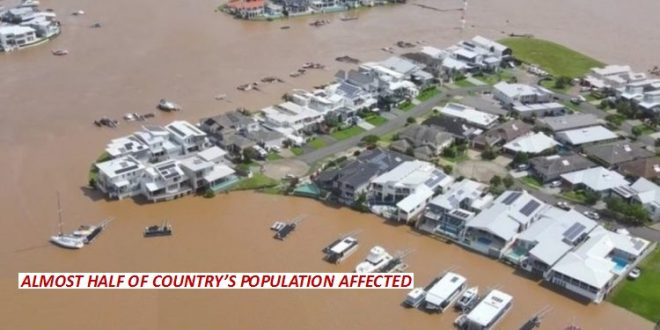22-03-2021
By SJA Jafri + Bureau Report
SYDNEY: Some 18,000 people have been evacuated from severe floods across New South Wales (NSW) in Australia, with more heavy rainfall predicted.
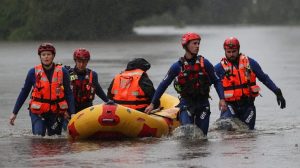 The state’s entire coast is now under a severe weather warning.
The state’s entire coast is now under a severe weather warning.
Days of torrential downpours have caused rivers and dams to overflow around Sydney – the state capital – and in south-east Queensland.
The military is being deployed to help with search and rescue, in what has been called a “one-in-50-years event”.
Australia’s Bureau of Meteorology has forecast “increased rainfall, strong winds, damaging surf and abnormally high tides” in New South Wales on Tuesday.
It also said that some 10 million people across every state and territory except Western Australia were now under a weather warning.
NSW Premier Gladys Berejiklian said no deaths had been reported by late Monday – describing it as “a miracle given what we have been through”, but 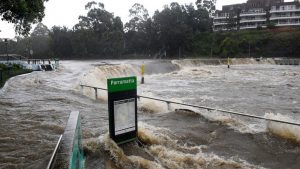 there has been widespread damage in the affected areas, which are home to about a third of Australia’s 25 million people.
there has been widespread damage in the affected areas, which are home to about a third of Australia’s 25 million people.
Ms Berejiklian said many of the communities “being battered by the floods” had been affected by bushfires and drought the previous summer.
“I don’t know any time in state history where we have had these extreme weather conditions in such quick succession in the middle of a pandemic,” she said.
PM Scott Morrison has offered funds for those forced to evacuate. He told parliament there was “serious risk still ahead”.
What’s the latest on the ground?
Swollen rivers cut off roads and bridges, and almost 200 schools in NSW will 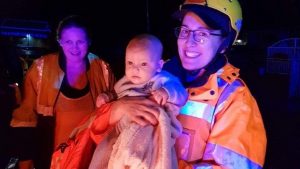 remain shutting on Tuesday.
remain shutting on Tuesday.
People in more than 15 mostly low-lying areas have been ordered to evacuate and a similar number have been given evacuation warnings.
An order requires people to seek shelter with friends well away from flood impacted areas, or in a special centre. The warning tells people to prepare for an evacuation order.
Areas north and west of Sydney, the NSW Central Coast and the Hawkesbury valley have been of particular concern.
There have been some 15,000 evacuations from the Mid-North Coast and a further 3,000 in Sydney, officials said.
The Australian Defence Force will provide search and rescue helicopters on Tuesday, after a request from the NSW government.
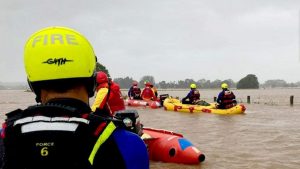 PM Morrison told MPs: “Across NSW, 1,400 first responders have conducted over 700 flood rescues and responded to over 7,500 requests for assistance.”
PM Morrison told MPs: “Across NSW, 1,400 first responders have conducted over 700 flood rescues and responded to over 7,500 requests for assistance.”
He added: “This is an ongoing situation that is evolving and is extremely dangerous.”
One stranded family was lifted from their flooded home by a helicopter. Responders also saved a family with a baby from flooding in their home in Sydney’s west.
There have been images of dead wildlife, livestock floating through flooded areas and rows of houses engulfed up to their windows.
The Hawkesbury and Nepean rivers which border Sydney to the north and west reached higher levels on Monday than during a devastating flood in 1961.
Meanwhile, the Warragamba Dam, Sydney’s main water source, began 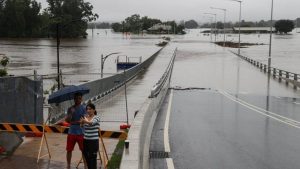 spilling over for the first time in five years. It reached a peak daily discharge on Sunday of 500 gigalitres, equivalent to the volume of Sydney Harbour – before falling back to 300 GL on Monday.
spilling over for the first time in five years. It reached a peak daily discharge on Sunday of 500 gigalitres, equivalent to the volume of Sydney Harbour – before falling back to 300 GL on Monday.
On Sunday a young couple saw their house north Sydney swept away by floods on what should have been wedding day. Shocked neighbors filmed the uprooted three-bedroom cottage bobbing along the Manning River after it burst its banks.
In Port Macquarie’s North Shore, one resident was filmed dragging a stingray through what was his front lawn.
In south-east Queensland, flash floods also affected Brisbane and the Gold Coast at the weekend.
Conditions in many areas of New South Wales are expected to worsen, with officials warning that two weather systems could collide, creating a “last blast” of rain and storms going into Wednesday.
The Bureau of Meteorology said heavy rainfall would affect the whole NSW coast and several inland areas on Tuesday, bringing a “serious risk” of flash flooding.
“This situation is far from over,” it tweeted but it added: “Most areas of New South Wales will see a clearing trend early Wednesday as drier air-mass moves into the region.”
It also sent out a tweet saving 10 million Australians were now under a weather warning, affecting an area the size of Alaska.
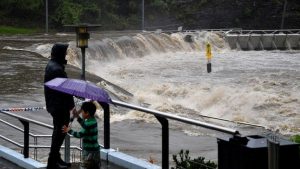 The bureau said the rainfall so far – up to 90cm in some areas had been “extraordinary”, with many areas across NSW resembling an “inland sea”.
The bureau said the rainfall so far – up to 90cm in some areas had been “extraordinary”, with many areas across NSW resembling an “inland sea”.
Ms Berejiklian, the NSW premier, said: “What we’re going through now is different to what you’ve been through for the last 50 years, so please take it seriously.”
Jamison-Town resident Ellen Brabin told media that she had not seen floods as severe as this in more than 40 years.
“I’ve seen all the floods and stuff, and never had to move before so this is different,” she said.
From fires to floods
The intense summer of rain and floods in eastern Australia is a stark contrast to a year ago, when many of the same areas were scorched by mammoth 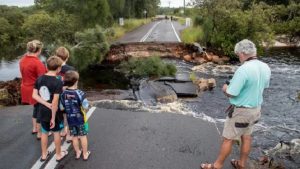 bushfires and ravaged by drought.
bushfires and ravaged by drought.
This side of the continent is currently experiencing a La Niña weather pattern, which typically brings more rainfall and tropical cyclones during summer.
Two of Australia’s three wettest years on record have been during La Niña events. Typically a La Niña sees a 20% increase in average rainfall from December to March in eastern Australia.
Scientists say that climate change is also intensifying La Niña’s impact, and making weather patterns more erratic.
 Pressmediaofindia
Pressmediaofindia
